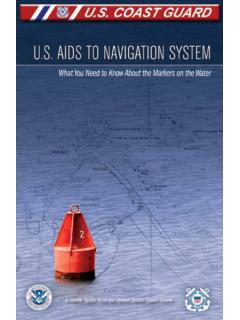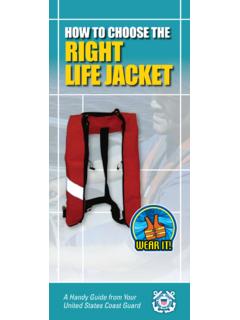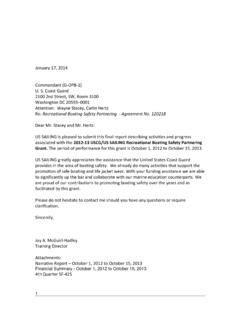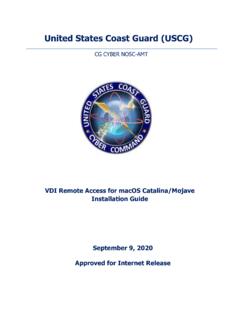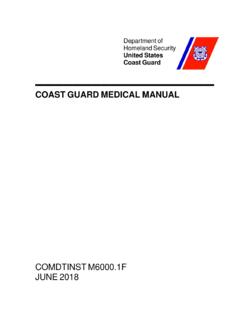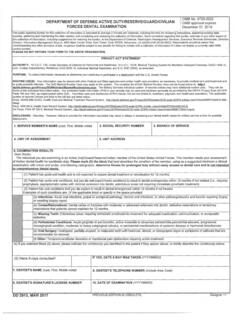Transcription of United States Coast Guard and Environmental Protection ...
1 2011 American Boat & Yacht Council, Inc. United States Coast Guard and Environmental Protection Agency Compliance Guideline -How to Comply with the Law- Fuel and Emissions Prepared by the American Boat & Yacht Council, Inc. 613 Third Street, Suite 10 Annapolis, MD 21403 (410) 990-4460 2011 American Boat & Yacht Council, Inc. TABLE OF CONTENTS General Applicability 1 EPA-What evaporative emission requirements apply under this part? 4 Definitions 5 General 11 EPA-Does this part apply for my products?
2 11 Equipment Standards Fuel Tanks 12 EPA-How do I test fuel tanks for permeation emissions? 18 Fuel Tanks: Prohibited Materials 19 Fuel Tanks: Labels 21 EPA-How must I label and identify the engines and equipment I produce? 22 EPA-How must I label and identify the fuel-system components I produce? 24 Cellular Plastic Used to Encase Fuel Tanks 29 Fuel Tank Openings 32 Fuel Tank Vent Systems 34 Fuel Pumps 36 Carburetors 41 Fuel Stop Valves 45 Spud, Pipe, and Hose Fitting Configuration 47 Clips, Straps, and Hose Clamps 48 Fuel Filters and Strainers 50 Seals and Gaskets in Fuel Filters and Strainers 51 Metallic Fuel Line Materials 52 Hoses: Standards and Markings 53 EPA-How must I label and identify the fuel-system components I produce?
3 54 Fuel Systems 57 Manufacturing Requirements Fuel Tanks: Installation 59 Plastic Encased Fuel Tanks: Installation 66 Fittings, Joints, and Connections 68 Plugs and Fittings 71 Hoses and Connections 72 EPA-What evaporative emission requirements apply under this part? (2) Fuel line fittings 79 Hose Clamps: Installation 80 Metallic Fuel Lines 84 Fuel Tank Fill System 85 EPA- What evaporative emission requirements apply under this part? (3) Refueling 91 Fuel Pumps: Placement 92 Anti-Siphon Protection 93 Fuel Filters and Strainers: Installation 96 Grounding 98 Tests Static Pressure Test for Fuel Tanks 100 2011 American Boat & Yacht Council, Inc.
4 Shock Test 104 Pressure Impulse Test 109 Slosh Test 114 Fire Test 117 Appendix Appendix A References 122 Appendix B Typical Components Used in EPA Compliant Systems 124 Appendix C Test Enclosure for Temperature Tests 127 Appendix D Types of Acceptable Lock Seams 127 2011 American Boat & Yacht Council, Inc. FIGURES AND TABLES FIGURE 1 Applicability 2 TABLE I Timeline for Implementation EPA 40 CFR Part 1060 5 FIGURE 2 A Typical Fuel System 7 FIGURE 3 Static Floating Position 9 FIGURE 4 Fuel Tank Pressure 13 FIGURE 5 Pressure versus Height 14 FIGURE 6 Fuel Tank Shock Test 16 FIGURE 7 Fuel Tank Label 21 FIGURE 8 Fuel Tank Label 25 FIGURE 9 Pressure Sensitive Label 28 TABLE II Foam Requirements 31 FIGURE 10 Fuel Tank Openings 33 FIGURE 11 Fuel Pumps.
5 Diaphragm Type 36 FIGURE 12 Wiring Diagram For Electric Fuel Pump 38 FIGURE 13 Fuel Pump Leakage Test 40 FIGURE 14 Updraft Carburetor 44 FIGURE 15 Electrically Operated Fuel Stop Valve 45 FIGURE 16 Leakage Test for Valves 46 FIGURE 17 Spud, Pipe and Hose Fittings 47 FIGURE 18 Hose Clamp Tensile Test 49 FIGURE 19 Leakage Test for Fuel Filters and Strainers 50 FIGURE 20 Seals And Gaskets Leakage Test 51 FIGURE 21 Hose Marking 56 FIGURE 22 Foamed-in-Place Non-Ferrous Metallic Tank 63 TABLE III Strength Tests for Fuel Tanks 65 FIGURE 23 Encased Fuel Tank Connections, Fittings and Label Accessibility 66 FIGURE 24 Failure of Encasement Materials 68 FIGURE 25 Examples 70 TABLE IV Length of Hose vs.
6 Five Ounce Fuel Capacity 74 TABLE 8 Hoses and Connections 76 FIGURE 26 Hose Connections 78 FIGURE 27 Examples of satisfactory installation 81 FIGURE 28 Hose Clamp Types 83 FIGURE 29 Metallic Fuel Line Support 85 FIGURE 30 Fuel Fill Locations 86 FIGURE 31 Fuel Overflow Test 87 FIGURE 32 Fuel Tank Hose Clamping 90 FIGURE 33 Remote Fuel Pump 92 FIGURE 34 Anti-Siphon Protection 95 FIGURE 35 Fuel Filter or Strainer Support 97 FIGURE 36 Typical Fuel Tank Pressure Test 99 FIGURE 37 Typical Fuel Tank Pressure Test 100 FIGURE 38 Test Pressure Determination 102 FIGURE 39 Fuel System Test Pressure 103 FIGURE 40 Shock Test - Fuel Tank Mounting 105 FIGURE 41 Fuel Tank Installed Anywhere in the Boat 107 FIGURE 42 Fuel Tank Installed Aft of the Half-Length 108 FIGURE 43 Pressure Impulse Test Applicability 110 FIGURE 44 Fuel Tank Mounting for Testing 111 FIGURE 45 Pressure Impulse Test 114 FIGURE 46 Slosh Test - Fuel Tank Mounting 116 TABLE V Fire Test Selection 118 2011 American Boat & Yacht
7 Council, Inc. FIGURE 47 Fire Test in Typical Fire Chamber 119 FIGURE 48 Fuel Component Fire Test on an Engine 120 FIGURE 49 Fuel Tank Fire Test in a Simulated Hull Section 121 2011 American Boat & Yacht Council, Inc. INTRODUCTION There are many requirements for the fuel system of gasoline powered inboard boats. They may be found in Title 33 CFR, Part 183, Sub Part J and Title 40 CFR Parts 1045 and 1060. Some of these requirements may be specifically applied but many are dependent on other requirements.
8 Some of the requirements should be complied with only if certain conditions of installation are selected or if certain types of fuel system products or components are used. This many faceted approach may lead to confusion. As this is a compilation of regulations from multiple government bodies written over many years, some of the definitions and terms may not be consistent. For example, the 33 CFR 183 is a safety related regulation and pertains to gasoline engines. The 40 CFR 1060 is an Environmental regulation and pertains to spark ignition (SI) engines.
9 Gasoline and SI engines are referring to the same engine type resulting in multiple regulations for the same engine type but under different titles. This document serves to help the marine industry understand what is required during a boat s construction. Regulations are typically written in concise terms, the words and arrangements chosen to be enforceable and in some cases to be legally interpreted. A regulatory format does not allow for explanations, recommendations and easily detected alternate solutions.
10 A regulation provides an outline about which a great deal of further information, interpretation, explanation, clarification and some helpful hints are needed in order to provide a good understanding and compliance with its intent. This fuel system guideline assists the designer, boat builder, surveyor and repairer to achieve compliance with the regulation. The guideline explains, interprets, clarifies, provides alternatives, diagrams, tabulates, makes recommendations, and in general, compliments the regulation to improve the user s understanding.

